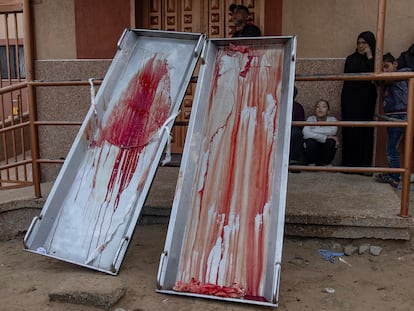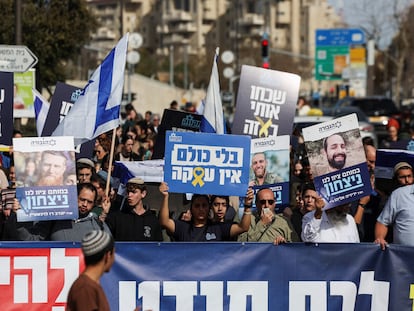Israel and Hamas sign ceasefire deal, set to begin on Sunday if approved by Netanyahu government
Among the 33 hostages to be released in the initial phase of the agreement are two young children and three individuals over 80 years old. Meanwhile, Israeli fighter jets continue to carry out intense bombing campaigns in Gaza
Despite delays and concerns, the ceasefire agreement in Gaza is progressing toward becoming a reality. The office of Israeli Prime Minister Benjamin Netanyahu announced early Friday that delegations from Israel and the Palestinian Hamas movement attending talks in Doha had signed the agreement initially announced by mediators Qatar, the U.S., and Egypt on Wednesday, but that was later blocked due to last-minute disagreements. Deadlines have been tight but are holding, even as intense Israeli airstrikes on Gaza continue. According to the Gazan emergency services, 101 people, mostly women and children, have died since the agreement was announced on Wednesday.
Israel’s security cabinet approved the deal Friday, with the government expected to ratify it later in the afternoon, before Sabbath begins. If, as anticipated, both sides give the green light and no unforeseen issues arise, the exchange of hostages for Palestinian prisoners will begin on Sunday, the originally planned date, Netanyahu’s office confirmed. Before implementation, there will be a period for Supreme Court objections, which is not expected to cause significant delays.
On Friday morning, the Israeli press published the names of 33 hostages set to be released in the first phase of the agreement. Among them are two young children, aged two and five, along with their parents, as well as three individuals over the age of 80. French President Emmanuel Macron confirmed that two of the hostages hold French citizenship. The first group of hostages to be returned includes women, men over 50, and individuals categorized as “humanitarians,” such as minors and the ill. It is not known for sure how many hostages are still alive.
Hamas initially refused to include military reservists in the first phase of the hostage exchange, but eventually relented. During negotiations, the Palestinian party-militia claimed it could not provide an advance list of hostages due to ongoing bombings and concerns about revealing their locations. Israel ultimately agreed to proceed with the exchange without a confirmed list, and believes that the hostages in this phase are primarily civilians. However, there are greater concerns for the second phase, which is expected to involve soldiers, as there is a fear of more bodies being included.
The exact number of Palestinian prisoners to be released will depend on the number of hostages still alive. Local media reports indicate that the first exchange — scheduled for Sunday — will involve three civilian women. The next exchange, a week later, will include another four hostages.
During the approximately six weeks of the first phase, Israel will begin to gradually withdraw its troops from Gaza, start releasing Palestinian prisoners (some of whom may be sent abroad), and allow displaced residents from northern Gaza to return to their homes if they remain standing.
The anticipation for the hostages’ return is palpable in Israel, reflected in headlines like “Waiting for everyone to come home” (Yediot Aharonot), “Holding our breath” (Haaretz), and “Waiting for them” (Israel Hayom). This moment touches a deeply sensitive national nerve and is part of the national ethos.
However, not everyone shares the enthusiasm. National Security Minister Itamar Ben Gvir, a far-right figure, announced that his party would resign from the ruling coalition if the “disastrous” and “irresponsible” pact is approved and implemented. However, he said he would continue to support Netanyahu but not as “partners in a defeatist agreement.” The ceasefire agreement, he said, “releases hundreds of terrorists with blood on their hands, who, upon their release, will seek to murder the next Jew” and “undoes all the war successes that cost us so much blood.” Ben Gvir also called for completely cutting off Gaza’s water, electricity, and aid supplies to force Hamas to release all hostages.
The pivotal factor lay in the stance of Finance Minister Bezalel Smotrich, the most influential ultra-nationalist figure in the government. Following five meetings over two days with Netanyahu, an undisclosed agreement was reached to ensure that Smotrich’s Religious Zionism party remains in the coalition. While Smotrich plans to vote against the ceasefire deal, he has agreed not to withdraw from the governing alliance, which includes Netanyahu’s Likud party and ultra-Orthodox partners.
The broader ceasefire agreement aims to solidify peace but hinges on key backroom negotiations involving Netanyahu and incoming U.S. President Donald Trump, whose administration leans toward extreme Israeli right-wing positions.
The agreement signed Friday morning aims to establish a lasting ceasefire, but its implementation will largely hinge on the political maneuvers and agreements between Netanyahu and Donald Trump, who is set to assume the U.S. presidency next Monday. Trump’s administration has already appointed officials aligned with the far-right elements of Israeli politics to influential positions. These dynamics will influence decisions on critical issues such as renewed bombings in Gaza if Hamas is perceived as regrouping, the annexation of occupied West Bank territories, and strategic actions regarding Iran — a priority concern for both leaders.
Sign up for our weekly newsletter to get more English-language news coverage from EL PAÍS USA Edition
Tu suscripción se está usando en otro dispositivo
¿Quieres añadir otro usuario a tu suscripción?
Si continúas leyendo en este dispositivo, no se podrá leer en el otro.
FlechaTu suscripción se está usando en otro dispositivo y solo puedes acceder a EL PAÍS desde un dispositivo a la vez.
Si quieres compartir tu cuenta, cambia tu suscripción a la modalidad Premium, así podrás añadir otro usuario. Cada uno accederá con su propia cuenta de email, lo que os permitirá personalizar vuestra experiencia en EL PAÍS.
¿Tienes una suscripción de empresa? Accede aquí para contratar más cuentas.
En el caso de no saber quién está usando tu cuenta, te recomendamos cambiar tu contraseña aquí.
Si decides continuar compartiendo tu cuenta, este mensaje se mostrará en tu dispositivo y en el de la otra persona que está usando tu cuenta de forma indefinida, afectando a tu experiencia de lectura. Puedes consultar aquí los términos y condiciones de la suscripción digital.
More information
Archived In
Últimas noticias
$3,000 and a plane ticket: The United States increases incentives for migrants to self-deport before the end of the year
Charles Dubouloz, mountaineering star, retires at 36 with a farewell tour inspired by Walter Bonatti
From the White House to diplomatic gifts: Lego wins over adult fans, brick by brick
Kate Winslet makes her directorial debut: ‘There aren’t more female directors because we’re busy raising children’
Most viewed
- Families demand repatriation of bodies of Colombians who died in Ukraine: ‘This war is a slaughterhouse for foreigners’
- The low-cost creative revolution: How technology is making art accessible to everyone
- Liset Menéndez de la Prida, neuroscientist: ‘It’s not normal to constantly seek pleasure; it’s important to be bored, to be calm’
- Christian Louboutin: ‘Young people don’t want to be like their parents. And if their parents wear sneakers, they’re going to look for something else’
- Christmas loses its festive spirit: ICE fears cast shadow over religious celebrations











































